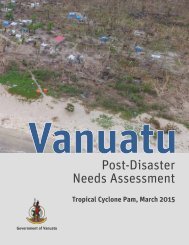Fiji
yqgk302EGjo
yqgk302EGjo
You also want an ePaper? Increase the reach of your titles
YUMPU automatically turns print PDFs into web optimized ePapers that Google loves.
FIJI Post-Disaster Needs Assessment<br />
2.2.2 ESLP Sector Background<br />
Employment and Livelihoods<br />
<strong>Fiji</strong> faces a paradox of a low unemployment rate with high informal sector employment, high underemployment, and<br />
significant and pervasive engagement in subsistence activities.<br />
In 2010/2011, <strong>Fiji</strong>’s population aged 15 and over (working age population) totaled just below 600,000 (Figure 12).<br />
Approximately 64.4 percent of this population (or around 386,000) participated in the labour market (81.5 percent for<br />
men and 46.6 percent for women). Among labour force participants, 95.3 percent were employed while 4.7 percent were<br />
unemployed. Among the employed, almost 60 percent were in informal employment, defined as employed people not<br />
making contributions to the <strong>Fiji</strong> National Provident Fund (FNPF), leaving the majority of workers without income security for<br />
old age or to deal with shocks.<br />
Some 24 percent of the employed labour force is involved with subsistence work, which is concentrated in the agriculture<br />
sector. Only five percent of agricultural workers contribute to the FNPF. Self-employed people and students aged 15<br />
and over can voluntarily join the fund, but voluntary contributions remain limited (just one percent, or F$2.3 million out of<br />
F$375.7 million in 2014). 21 Almost 79 percent of rural workers are informally employed, compared with less than 40 percent<br />
of urban workers.<br />
The labour market also shows significant gender disparities, with men representing almost two-thirds of the labour force in<br />
2010/2011. While the proportion of males in informal employment accounted for 57 percent (2010/11), females accounted<br />
for about 65 percent of informal employment. A gender gap of 34.9 percent in labour force participation rates suggests<br />
significant opportunity to engage more women to meet the challenges of sustainable development.<br />
Unemployment rates for youth aged 15-24 in 2010/11 was 15 percent, almost four times higher than people aged 25-<br />
44 and almost 14 times higher than the 45-64 age group. Young women, in particular, have trouble finding jobs, with an<br />
unemployment rate of 19.5 percent compared with 12.9 percent for young men. A significant number of young women<br />
and men are also not receiving an education. In 2010/2011, the share of people aged 15-24 who were neither employed<br />
nor educated was 17.6 percent, down from 18.6 percent in 2004/2005. However, this share is three times higher for<br />
young women (27.5 percent) than young men (8.8 percent), primarily because women are responsible for more household<br />
duties. 22<br />
Three siblings stand on what was once a vegetable farm<br />
Source: Murray Lloyd/UN Women<br />
21<br />
FNPF 2014.<br />
22<br />
ILO/ADB <strong>Fiji</strong> Creating Quality Jobs: Employment Diagnostic Study 2015.<br />
Tropical Cyclone Winston, February 20, 2016<br />
29



